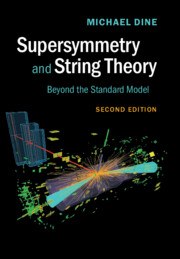Book contents
- Frontmatter
- Dedication
- Contents
- Preface to the First Edition
- Preface to the Second Edition
- A note on the choice of metric
- Text website
- Part 1 Effective field theory: the StandardModel, supersymmetry, unification
- 1 Before the Standard Model
- 2 The Standard Model
- 3 Phenomenology of the Standard Model
- 4 The Standard Model as an effective field theory
- 5 Anomalies, instantons and the strong CP problem
- 6 Grand unification
- 7 Magnetic monopoles and solitons
- 8 Technicolor: a first attempt to explain hierarchies
- Part 2 Supersymmetry
- Part 3 String theory
- Part 4 Appendices
- References
- Index
8 - Technicolor: a first attempt to explain hierarchies
from Part 1 - Effective field theory: the StandardModel, supersymmetry, unification
- Frontmatter
- Dedication
- Contents
- Preface to the First Edition
- Preface to the Second Edition
- A note on the choice of metric
- Text website
- Part 1 Effective field theory: the StandardModel, supersymmetry, unification
- 1 Before the Standard Model
- 2 The Standard Model
- 3 Phenomenology of the Standard Model
- 4 The Standard Model as an effective field theory
- 5 Anomalies, instantons and the strong CP problem
- 6 Grand unification
- 7 Magnetic monopoles and solitons
- 8 Technicolor: a first attempt to explain hierarchies
- Part 2 Supersymmetry
- Part 3 String theory
- Part 4 Appendices
- References
- Index
Summary
In Chapter 5 we learned a great deal about quantum chromodynamics. In Section 4.5 we argued that the hierarchy problem is one of the puzzles of the Standard Model. The grand unified models of Chapter 6 provided a quite stark realization of the hierarchy problem. In an SU(5) grand unified model we saw that it is necessary to adjust carefully the couplings in the Higgs potential in order to obtain light doublet and heavy color triplet Higgs. This is already true at tree level; loop effects will correct these relations, requiring further delicate adjustments.
Attempts to understand the hierarchy problem in a manner consistent with 't Hooft's naturalness principle fall into three broad categories: the dynamical breaking of electroweak symmetry, supersymmetry (in which it is still possible that the breaking of electroweak symmetry is dynamical), geometric approaches (large extra dimensions or warped space– times) and supersymmetry. The present chapter gives a brief introduction to dynamical models; Chapters 9–16 will deal with supersymmetry both as a possible new symmetry of nature and a possible solution to the hierarchy problem. We will discuss geometric solutions in Chapter 29 after we have learned about theories of space–time, i.e. general relativity and string theory.
The first proposal to resolve the hierarchy problem goes by the name technicolor. The technicolor hypothesis exploits our understanding of QCD dynamics. It elegantly explains the breaking of the electroweak symmetry. It has more difficulty accounting for the masses of the quarks and leptons, and simple versions seem incompatible with precision studies of the W and Z particles and now the discovery of a Standard-Model-like Higgs boson. In this chapter we will introduce the basic features of the technicolor hypothesis. We will not attempt to review the many models that have been developed to try to address the difficulties of flavor and precision electroweak experiments. It is probably safe to say that, as of this writing, none is totally successful nor particularly plausible. But it should be kept in mind that this may reflect the limitations of theorists; experiment may yet reveal that nature has chosen this path. In any case, the study of these theories will deepen our understanding of the Standard Model and of strongly coupled quantum field theories and will open our eyes to possibilities for new physics.
- Type
- Chapter
- Information
- Supersymmetry and String TheoryBeyond the Standard Model, pp. 126 - 132Publisher: Cambridge University PressPrint publication year: 2016



